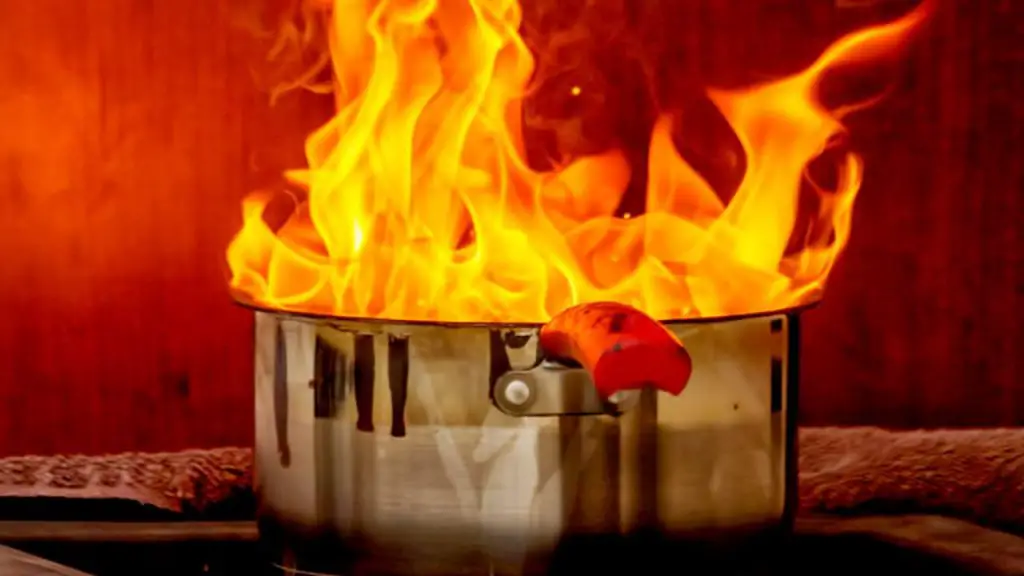A grease fire occurs when cooking oil or fat ignites due to high heat. These fires can be extremely dangerous and can quickly spread, making it crucial for individuals to understand the proper steps to take in case of a grease fire.
The purpose of this article is to provide readers with comprehensive information on what happens when water is put on a grease fire, alternative methods for putting out a grease fire, and steps for preventing and preparing for a grease fire.
What happens when you put water on a grease fire
Putting water on a grease fire is a common mistake made by many people when attempting to put out a kitchen fire.
However, this can actually be extremely dangerous and can make the fire even worse.
When water is poured onto a grease fire, it rapidly vaporizes and creates steam, which can cause the grease to splatter and spread the fire.
Additionally, water is not able to mix with grease and will instead cause the grease to float on top of the water, potentially leading to a flare-up of the fire.
The heat from the fire can cause the water to boil, leading to an increase in steam pressure which can cause the pot or pan to explode, sending burning grease and hot water in all directions, putting those nearby at risk of injury.
The sudden release of steam can also cause the grease to quickly ignite, causing an even larger fire.
In conclusion, using water to put out a grease fire is not recommended and can actually make the situation worse.
Instead, it is recommended to use a fire extinguisher specifically designed for kitchen fires or to smother the fire by placing a lid on the pot or pan, cutting off the fire’s oxygen supply.
If the fire is too large to be controlled, it is important to evacuate the premises immediately and call the fire department.

Alternative methods to put out a grease fire
- Use of a fire extinguisher: A fire extinguisher is one of the most effective methods for putting out a grease fire. It is important to choose the right type of fire extinguisher, as some fire extinguishers are specifically designed for grease fires.
- Smothering the fire with a lid or baking soda: Covering the fire with a lid or baking soda can help to smother the fire and prevent it from spreading. This method works by removing the oxygen supply that the fire needs to survive.
- Evacuation and calling emergency services: In case of a severe grease fire, it is important to evacuate the premises immediately and call emergency services. Do not attempt to put out the fire yourself if it is too big or out of control.
- Using a fire blanket: A fire blanket can be used to smother the fire and cut off the oxygen supply. It is a safer option than using a fire extinguisher, as it reduces the risk of injury and is less likely to cause damage to the kitchen.
- The ABCs of fire extinguishers: It is important to understand the different types of fire extinguishers and their uses. Class A fire extinguishers are best for grease fires, while class B fire extinguishers are suitable for flammable liquid fires.
Prevention of grease fires
- Proper cooking techniques: To prevent grease fires, it is important to use proper cooking techniques. This includes using a thermometer to monitor the temperature of the cooking oil, avoiding overcrowding the pan, and never leaving the kitchen when cooking on the stove.
- Keeping the kitchen clean: Keeping the kitchen clean and free of grease and oil buildup can help to prevent grease fires. This includes regularly cleaning the stove, oven, and fryer, and properly disposing of used cooking oil.
- Staying alert and vigilant when cooking: It is important to stay alert and vigilant when cooking to prevent grease fires. This means avoiding distractions, such as using your phone or watching TV, and keeping a close eye on the food while it is cooking.
- Proper storage of flammable liquids: Flammable liquids, such as cooking oil and gasoline, should be stored in a cool, dry place away from heat sources.
- Regular maintenance of cooking appliances: Regular maintenance of cooking appliances, such as the stove, oven, and fryer, can help to prevent grease fires. This includes cleaning the appliances, checking for worn or damaged parts, and replacing any faulty parts.
Preparing for a grease fire
- Creating a fire evacuation plan: Creating a fire evacuation plan is important in case of a grease fire. This includes identifying the nearest exits, determining an escape route, and ensuring that everyone in the home or workplace is aware of the plan.
- Installing smoke detectors and fire alarms: Installing smoke detectors and fire alarms can help to alert individuals in the event of a fire, providing them with sufficient time to evacuate the premises.
- Keeping a fire extinguisher readily available: Keeping a fire extinguisher readily available and in an easily accessible location can help to quickly put out a grease fire before it spreads.
- Educating family members or coworkers on fire safety: Educating family members or coworkers on fire safety, including the proper steps to take in case of a grease fire, can help to prevent injury and minimize damage in the event of a fire.
Conclusion
Grease fires can be extremely dangerous and can quickly spread, making it crucial for individuals to understand the proper steps to take in case of a grease fire.
By understanding the dangers of putting water on a grease fire, alternative methods for putting out a grease fire, and steps for preventing and preparing for a grease fire, individuals can reduce the risk of injury and minimize damage in the event of a fire.
Regular maintenance, proper cooking techniques, staying alert and vigilant when cooking, and creating a fire evacuation plan can all help to prevent and prepare for a grease fire.
Additional Posts:


